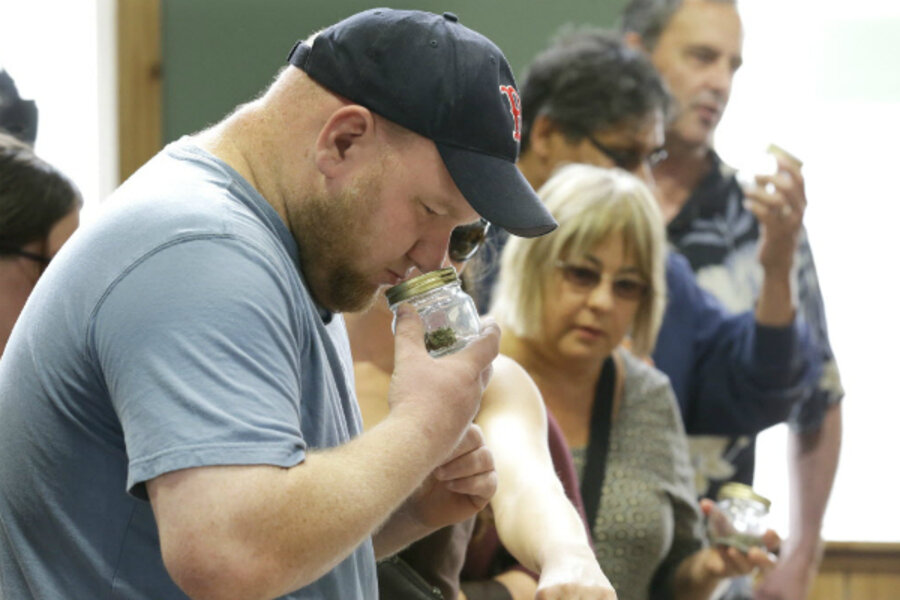Pot learning curve: Washington cribs from Colorado's legalization rollout
Loading...
| Boulder, Colo.
Residents of Washington State could buy recreational marijuana legally for the first time Tuesday – though only about six of the 24 shops issued licenses planned to be open for the first day of business.
It's a sharp contrast to Colorado, which legalized marijuana at the same time as Washington (Nov. 6, 2012), but where pot shops have been selling the drug to recreational users since Jan. 1 of this year. Colorado also issued 136 licenses to sell recreational pot before that date, although only about 40 began selling it in the first week of January.
The two states have been under scrutiny as they embark on test cases in legalization, watched closely by everyone from legalization critics to advocates pushing legal marijuana in other states, including Oregon and Alaska. Observers are keeping tabs both on how smoothly the rollout goes, as well as looking to the differences in the two states' approaches.
"We’re watching [the legalization process in Colorado and Washington] very closely, and it’s very useful," says Peter Zuckerman, a spokesman for New Approach Oregon, which has helped craft a ballot measure to legalize recreational marijuana in Oregon that will be on the ballot in November.
"From every measure that passes and gets implemented, we learn more. We're taking the best from Colorado and the best from Washington and tailoring it to Oregon," he adds.
The area of legalization under the most scrutiny in Colorado is the sale of "edibles" – marijuana-laced chocolate, candy, and other food items that critics say are appealing to children and are more potent, especially for novice users, than customers might realize.
In March, a college student visiting from Wyoming jumped to his death from a balcony after eating a pot cookie. Another man shot and killed his wife after eating pot-laced Karma Kandy. Emergency rooms have reported treating a number of children who became ill after unintentionally eating marijuana edibles.
Last month, New York Times columnist Maureen Dowd wrote about spending a paranoid and hallucinatory night in her Denver hotel after eating a few bites of a marijuana chocolate bar; a retailer later told her that as a novice, she should have consumed just 1/16th of the bar.
In response to Colorado's experiences, Washington last month issued some new rules governing the packaging, labeling, and sale of edibles, and it has yet to issue a license for a kitchen to produce such products.
"Edibles, labeling, dosage, and packaging will be big issues going forward," says Sam Kamin, a Denver University law professor who also served on Colorado's marijuana task force that made recommendations about regulation. "You want to be sure people know what they’re getting, that it’s clear, that they know how to use it. Those are issues we need to grapple with ... and that Washington State knows are going to be important as well."
Washington's slower rollout of implementation – due largely to the fact that it had a less-established medical marijuana structure in place compared with Colorado, which had been regulating a commercial medical pot market for several years – is just one of several differences in how the two states have approached legalization.
Having a regulated medical marijuana system "was a huge advantage, and a big part of the reason we rolled out at least six months before Washington," says Professor Kamin. "We had this wealth of experience and statutes on which we could draw."
Colorado also allows "home grows" of up to six plants per person; Washington does not. Colorado still has a thriving and highly regulated medical marijuana market that operates parallel to its recreational one (the first recreational licenses were given only to existing medical dispensaries); in Washington, the medical marijuana market exists as a sort of unregulated gray zone, with little legal clarity.
Colorado requires "vertical integration" of its industry, in which the same entity grows, processes, and sells the drug (though the requirement will eventually be phased out), while Washington prohibits it. Washington has also set up a different tax structure, with a 25 percent excise tax at three different points: grower to processor, processor to distributor, distributor to customer. Colorado has a 15 percent excise tax and a 10 percent sales tax, with localities also able to impose their own taxes.
Over the next months and years, pluses and minuses to both their systems should start to be clear, say observers. Allowing a home grow, for instance, has meant that from the moment it was legal to use recreational marijuana – Jan. 1, 2013 for both states – Colorado users had a legal means to get it, provided they knew someone who grew their own plants, says Professor Kamin. Because a key consideration in both states was to eliminate the black market, providing that outlet was important to those who drafted the measure.
On the other hand, he notes, going forward home grows could feed the black market, and undercut some of the goals of having a regulated system, such as generating tax revenue.
The limited supply of a legal market in Washington and the small number of stores opening this week have led to long lines and high prices. But Pete Holmes, Seattle's city attorney, says Washington's "go slow" approach is wise.
"It’s safe to say that Seattle and Washington State have had a progressive rollout," Mr. Holmes says. "We’ve built the system from the ground up, and I think it’s completely appropriate that it on-ramps in a gradual manner. That way we’re more certain we’re getting it right."
As the system expands, he adds, it will provide opportunities to ensure that things like computer-tracking systems, bookkeeping, and other safeguards are all working the way they're intended. "I think we’ll be able to avoid some of the real problems Colorado experienced."






